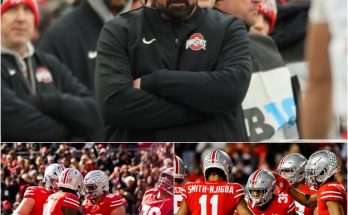In the sprawling, narrative-driven universe of college football, few institutions command a presence quite like The Ohio State University. Its legacy is etched in national championships, Heisman Trophies, and a ferocious, decades-long rivalry that defines the sport. Yet, perhaps the most profound and enduring measure of its impact is not the gold pants or the crystal footballs, but the men it forges for the ultimate stage: the National Football League. The claim that Ohio State has already sent six future Hall of Famers to the league is not mere fanfare; it is a statement of fact, a testament to a developmental pipeline that doesn’t just produce professional players, but sculpts legends. These six individuals represent different eras, positions, and personalities, but they are united by the scarlet and gray thread of their origin and the immutable bronze of their destiny in Canton.
The most recent and arguably most transformative of this elite group is quarterback Justin Fields. While his professional journey is still unfolding, his trajectory is one of breathtaking potential and paradigm-shifting talent. At Ohio State, Fields was a force of nature, a dual-threat quarterback who redefined the position’s ceiling in a single season. His 2019 campaign was a masterpiece: 41 touchdown passes against just 3 interceptions, coupled with 10 rushing touchdowns, leading the Buckeyes to the College Football Playoff. He demonstrated a rare blend of arm strength, pinpoint accuracy, and a running back’s physique and vision. In the NFL, despite early team struggles, Fields has already begun to rewrite the record books for quarterback rushing, showcasing a style of play that is forcing the entire league to reconsider offensive philosophy. His path to Canton will be paved with continued development as a passer and team success, but the raw materials of a revolutionary talent are undeniable. He is not just a player; he is a precursor, and the Hall of Fame has a place for those who change the game.
Moving to the heart of the defense, the case for Nick Bosa is one of overwhelming and relentless dominance. The Bosa name is already royalty in football circles, and Nick has not only upheld the legacy but has arguably surpassed it. At Ohio State, he was an unblockable vortex of destruction, a defensive end whose first step seemed to defy physics. His college career, though shortened by injury, was a preview of the havoc he would wreak at the professional level. Since being drafted by the San Francisco 49ers, Bosa has been the gold standard for defensive excellence. His 2019 Defensive Rookie of the Year award was a mere opening act. In 2022, he unleashed a season for the ages, leading the league with 18.5 sacks and capturing the NFL Defensive Player of the Year award, a crown reserved for the single most impactful defensive force in the sport. Bosa’s game is a blend of technical precision, explosive power, and an insatiable motor. He is the focal point of every offensive game plan, and he consistently defeats them. Barring catastrophe, his bust in Canton is not a matter of “if,” but “when,” and how many more accolades he will accumulate before his induction.
If Bosa represents the modern pass-rusher, offensive guard Quenton Nelson, who began his college career at Ohio State before transferring to Notre Dame, represents a slight twist in the narrative. However, his foundational year in Columbus cannot be entirely dismissed from his development. Yet, to stay strictly within the Buckeye-born lineage, we look to a player like Marshon Lattimore. Lattimore embodies the “DBU” moniker that Ohio State has rightfully claimed. In his lone season as a starter in Columbus, he was a lockdown corner, a first-round talent who shut down half the field. That transitioned seamlessly to the NFL with the New Orleans Saints, where he immediately won the NFL Defensive Rookie of the Year award in 2017. Lattimore didn’t just enter the league; he announced his arrival as a premier cover corner. His combination of elite recovery speed, physicality at the line of scrimmage, and innate ball skills has made him a perennial Pro Bowler and the cornerstone of the Saints’ defense for years. In an era dominated by passing attacks, shutdown cornerbacks are priceless commodities, and Lattimore’s sustained excellence at one of the game’s most demanding positions has him on a Hall of Fame path.
The thread continues with the tenacious and iconic center, Corey Linsley. A model of consistency and intelligence, Linsley was the bedrock of Ohio State’s offensive line in the early 2010s, snapping the ball to Braxton Miller and protecting him with aplomb. His professional career has been a masterclass in sustained, high-level performance. After a stellar tenure with the Green Bay Packers where he became one of the most respected linemen in the game, he continued his excellence with the Los Angeles Chargers. Linsley’s game is not about flashy highlights; it is about flawless technique, leadership, and a football IQ that allows him to anchor an offensive line against the most complex defensive schemes. His first-team All-Pro selection in 2020 cemented his status as the best center in football during that season. For interior offensive linemen, the path to Canton is often a long march built on respect and a portfolio of Pro Bowls and All-Pro honors. Linsley has been building that resume year after year, snap after snap, and his career embodies the quiet, essential greatness that the Hall of Fame was created to honor.



